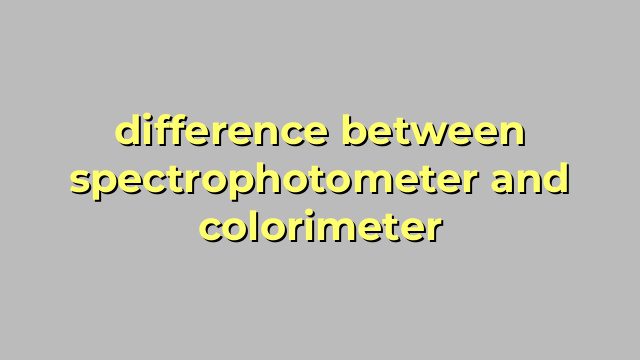Understanding the Difference between Spectrophotometer and Colorimeter
When it comes to color measurement, two of the most commonly used devices are spectrophotometer and colorimeter. While both of them serve the same purpose, there are some fundamental differences that set them apart.
What is a Spectrophotometer?
A spectrophotometer is an analytical instrument that measures the light intensity and its wavelength absorbed or transmitted by a substance. They use a monochromatic source to analyze the light that passes through a sample to provide the intensity of wideband spectrum. Spectrophotometers cover a broad spectrum of light and are capable of providing more detailed data. This makes them more suitable for sophisticated applications, such as determining specific concentrations of a substance.
What is a Colorimeter?
A colorimeter is a device that measures the intensity of light according to the color perceived by the human eye. A colorimeter uses a light source that has a specific frequency to measure the intensity of light that passes through a sample. Unlike spectrophotometers, colorimeters are limited to a specific range of the electromagnetic spectrum. They are commonly calibrated to match the sensitivity of the human eye so that it can measure the color of a sample.
The Differences between Spectrophotometer and Colorimeter
The main difference between spectrophotometer and colorimeter is their working principle. While spectrophotometers produce a spectrum of colors, colorimeters produce a single color. Spectrophotometers are more sensitive and can detect even the slightest variations in color, whereas colorimeters are less sensitive but more accurate for certain applications. Spectrophotometers are generally more expensive than colorimeters.
Another difference is the applications for which these devices are used. Spectrophotometers are typically used in scientific research, quality control, and medical laboratories, whereas colorimeters are commonly used in industries such as printing, textiles, and paint manufacturing, where accurate color reproduction is crucial.
Conclusion
In summary, both spectrophotometers and colorimeters serve a similar purpose of measuring color. However, their differences in sensitivity, range, cost, and applications make them suitable for different scenarios. Therefore, it is essential to choose the right tool for the job and understand the differences between these devices.
Table difference between spectrophotometer and colorimeter
| Feature | Spectrophotometer | Colorimeter |
|---|---|---|
| Function | Measures light as a function of wavelength and can determine the exact concentration of different components in a solution. | Detects the perceived color of a sample and provides measurements of its intensity and hue, but does not give information on individual components. |
| Measurement Range | Wide range, from ultraviolet to near-infrared wavelengths. | Limited range, typically covers only the visible spectrum. |
| Accuracy and Precision | Generally more accurate and precise due to the ability to measure different wavelengths and identify individual components. | May have slightly lower accuracy and precision because it cannot distinguish between different components in a sample, but still provides useful measurements for many applications. |
| Applications | Widely used in research, analytical chemistry, and quality control to measure the concentration of various substances in a solution. | Commonly used in industries such as food and beverage, textiles, and paint to ensure consistent color quality. |
| Cost | Generally more expensive than colorimeters due to their more complex design and wider range of measurements. | Less expensive than spectrophotometers and suitable for many industrial applications that do not require the highest level of accuracy. |


